COOPERATION MODEL
ARTIFICIAL INTELLIGENCE
PRODUCT ENGINEERING
DevOps & Cloud
LOW-CODE/NO-CODE DEVELOPMENT
INDUSTRY
FRONTEND DEVELOPMENT
CLOUD DEVELOPMENT
MOBILE APP DEVELOPMENT
LOW CODE/ NO CODE DEVELOPMENT
EMERGING TECHNOLOGIES







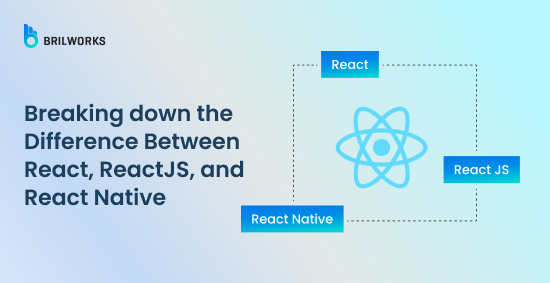
You've undoubtedly heard of React, ReactJS, and React Native if you've ever looked for JavaScript frameworks. These terms cause confusion for many developers, particularly novices. What distinguishes ReactJS from React? And what role does React Native play?
In a nutshell, React and ReactJS are interchangeable, but React Native is entirely distinct. React Native is a framework for creating cross-platform mobile apps, whereas React (or ReactJS) is a JavaScript library for creating web applications.
When choosing one for your project, it is essential to comprehend these distinctions. We'll explain everything in this blog, explain the distinction between React and React Native, and assist you in selecting the best tool for your development requirements.
Before moving on, let’s clear the first part of our blog title, which is the difference between React and ReactJS. So, the short answer is that the difference is “JS.” One name is used directly, and the other has JS at the end. React and ReactJS are interchangeable; they both refer to the same JavaScript library for building user interfaces.
So why do we see both terms?
React is the official name given by Meta (formerly Facebook) when they introduced the library in 2013.
ReactJS is an informal way of referring to React, simply emphasizing that it is a JavaScript-based library. Some developers and online resources use "ReactJS" to avoid confusion with other technologies that also use the name "React," such as React Native.
While both terms mean the same thing, "React" is the more commonly used and officially recognized name. If you browse through Meta’s documentation or most professional development circles, you’ll see "React" rather than "ReactJS."
The important takeaway here is that whether someone says React or ReactJS, they are talking about the same library used to build interactive web applications.
Also Read: Why Choose ReactJS for Mobile App Development?
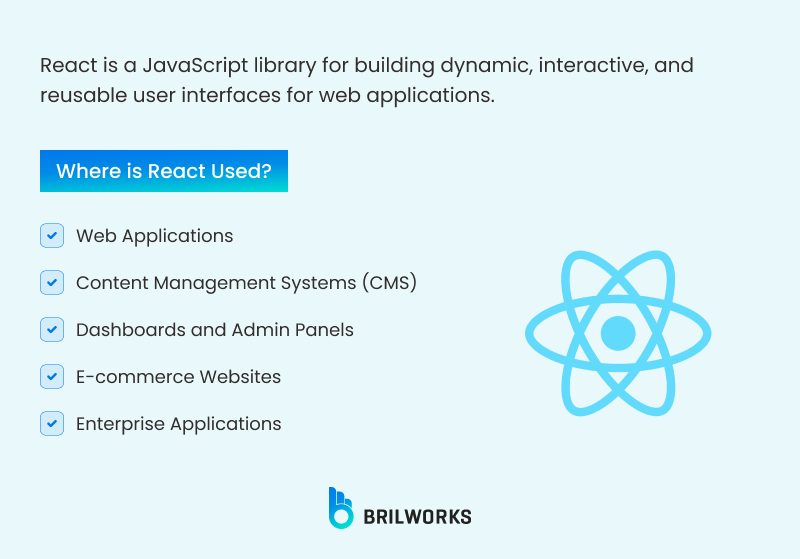
Now that we’ve established that React and ReactJS are the same, let’s take a closer look at what React actually is and why it’s so popular among developers.
React is a JavaScript library for building dynamic and interactive user interfaces, primarily for web applications. Developed by Meta (formerly Facebook) in 2013, it was designed to simplify the process of creating fast, scalable, and reusable UI components.
React allows developers to build UI components that update dynamically. Here’s a simple example of a React component that displays a counter:
import { useState } from "react";
function Counter() {
const [count, setCount] = useState(0);
return (
<div>
<h1>Counter: {count}</h1>
<button onClick={() => setCount(count + 1)}>Increase</button>
</div>
);
}
export default Counter;Explanation:
We use the useState hook to manage the counter’s state.
Clicking the button updates the count, and React efficiently updates only the necessary parts of the UI.
This is the core idea behind React—building reusable and interactive components with minimal updates to the actual DOM.
Component-Based Architecture - React applications are made up of reusable components, making development more efficient and easier to manage.
Virtual DOM - Instead of updating the entire web page when something changes, React updates only the necessary parts, improving performance.
Declarative UI - React allows developers to describe what the UI should look like in different states, making the code more predictable and easier to debug.
Unidirectional Data Flow - Data in React flows in one direction, making state management more structured and reducing unexpected bugs.
Strong Ecosystem - With tools like React Router for navigation and state management libraries like Redux, React provides a robust development experience.
React is primarily used for building single-page applications (SPAs), progressive web apps (PWAs), and complex web interfaces. Major companies like Netflix, Intagram, and WhatsApp Web rely on React for their front-end development.
Since React is a library (not a full-fledged framework), it focuses solely on the view layer of an application. This means developers often pair it with other technologies like Next.js for server-side rendering or Redux for state management.
Now that we understand React, let’s explore how React Native differs from it and why it exists in the first place.
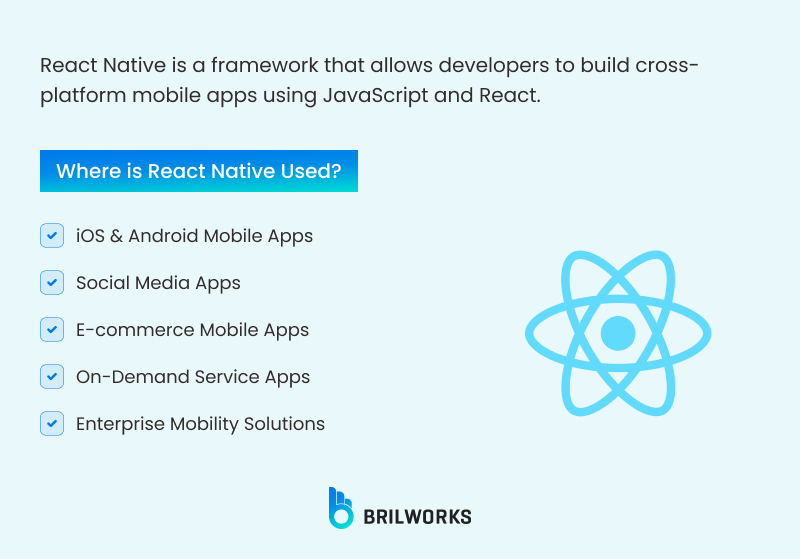
While React (ReactJS) is used to build web applications, React Native is a framework designed for building mobile applications. Introduced by Meta in 2015, React Native allows developers to create cross-platform mobile apps using JavaScript and React.
The catch here is that instead of rendering components as HTML elements like React does for the web, React Native renders native UI components for mobile platforms. This means that with a single codebase, developers can build apps for both iOS and Android, significantly reducing development time and effort.
React Native uses components similar to React, but instead of rendering HTML elements, it renders native UI components. Here’s an example of a simple React Native component:
function CounterApp() {
const [count, setCount] = useState(0);
return ( // Use parentheses instead of curly braces here
<View style={{ alignItems: "center", marginTop: 50 }}>
<Text style={{ fontSize: 24 }}>Counter: {count}</Text>
<Button title="Increase" onPress={() => setCount(count + 1)} />
</View>
);
}Explanation:
Instead of div and h1, React Native uses View and Text, which correspond to native UI components.
The Button component is platform-independent, rendering a native button on both iOS and Android.
The logic remains the same as React, but React Native bridges JavaScript with native code to ensure the best performance.
Cross-Platform Development – Write code once and run it on both iOS and Android, avoiding the need for separate native apps.
Uses Native Components – Instead of using web technologies like HTML and CSS, React Native directly interacts with native UI components, providing a smoother user experience.
Hot Reloading – Developers can see real-time changes in the app without restarting the entire build, improving development efficiency.
Access to Native APIs – React Native allows interaction with device features like camera, GPS, and push notifications using built-in modules or third-party libraries.
Performance Optimized – Unlike web-based solutions such as Ionic or Cordova, React Native uses a bridge to communicate with native code, offering better performance than traditional hybrid frameworks.
React Native is widely adopted by companies looking to develop high-quality mobile applications quickly. Some well-known apps built with React Native include:
Facebook - Meta’s own app partially uses React Native.
Instagram - Certain parts of the Instagram app, such as the push notification settings screen, were developed with React Native.
Uber Eats - The restaurant dashboard was built using React Native.
Discord - The popular messaging app uses React Native for both iOS and Android.
React Native has grown into one of the most preferred frameworks for cross-platform mobile app development, especially for startups and businesses looking to launch apps faster without maintaining separate native codebases.
Now that we understand what React and React Native are, let’s break down their key differences in the next section.
Need help choosing between ReactJS and React Native for your next project? Our React Native app development team has the hands-on expertise to guide you and build the right solution. Let’s chat today and turn your app idea into a powerful, high-performing product!
Understanding how React and React Native operate helps clarify why they’re suited for different platforms. Though they share similar design philosophies, their execution mechanisms differ considerably:
React operates primarily in the browser using the concept of a virtual DOM. When the state of an application changes, React creates a lightweight copy of the DOM (the virtual DOM) and compares it with the previous version using a diffing algorithm. This process identifies the minimal number of changes needed to update the actual DOM, resulting in a fast and efficient update cycle. The declarative nature of React means that developers describe what the UI should look like at any given state, and React takes care of rendering those changes seamlessly.
React Native extends the core concepts of React to mobile development by leveraging a bridge between JavaScript and native code. Instead of updating an HTML-based DOM, React Native translates components written in JavaScript (using JSX) into native UI elements. This means that a <View> in React Native corresponds directly to a native container on iOS or Android. The bridge facilitates communication between JavaScript and the native platform, ensuring that the application can respond to user interactions and perform animations smoothly while delivering a native experience.
They also differ in the rendering process:
React uses the virtual DOM to compare previous and current states and then selectively updates only the necessary parts of the real DOM.
React Native bypasses the HTML/CSS stack completely by directly mapping components to native widgets via the bridge, resulting in a true native user experience.
Both systems follow similar component lifecycles and use state and props to manage data flow. However, in React Native, these updates trigger changes in native components rather than web elements, which requires handling different performance considerations and native interactions.
React and React Native both use declarative programming and component-based architecture. React concentrates on updating web pages efficiently using the virtual DOM, while React Native uses a bridge to render native components and guarantee a smooth mobile experience. Each is particularly strong in its own field because of this architectural difference.
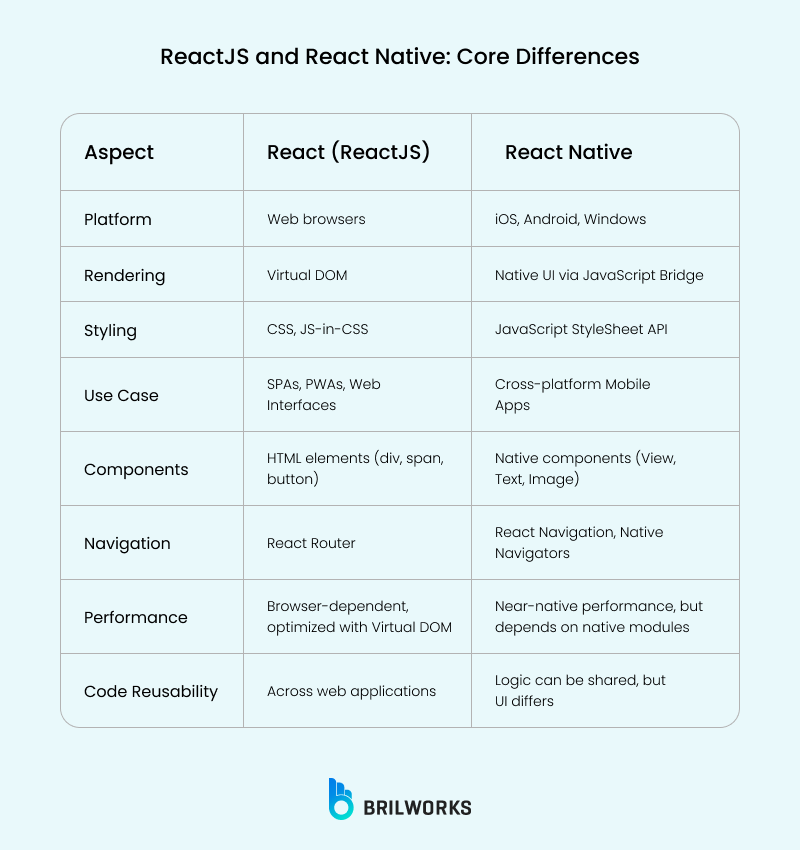
React is a JavaScript library tailored for building web applications. It primarily targets web browsers, enabling developers to create dynamic and interactive user interfaces that run seamlessly on desktop and mobile web platforms. With React, the output is rendered as HTML, making it an ideal choice for developing single-page applications (SPAs) and progressive web apps (PWAs).
React Native, in contrast, is designed specifically for mobile app development. It allows developers to create native mobile applications for platforms such as iOS, Android, and even Windows by using a shared JavaScript codebase. Instead of rendering HTML, React Native converts components into native widgets, ensuring that mobile apps deliver a genuine native look and performance.
React leverages a virtual DOM to efficiently render web pages. When the state or props of a component change, React calculates the difference between the previous and current virtual DOM representations. This diffing algorithm ensures that only the necessary parts of the actual DOM are updated, leading to improved performance in web applications.
React Native renders in a different way. Through a bridge that converts JSX-written React components into native UI elements, it interacts with the native platform. Bypassing the HTML/CSS stack on the web, this technique enables React Native to use native APIs and components to provide a mobile-friendly, high-performance experience.
In React, styling is usually accomplished with CSS, either through CSS-in-JS solutions, external style sheets, or inline styles. To improve the look and feel of web interfaces, developers can use a variety of styling approaches, including SASS/SCSS, traditional CSS, and libraries like Styled Components.
Styling in React Native is handled via JavaScript using the StyleSheet API. Unlike traditional web development, there is no HTML or CSS; instead, styles are defined as JavaScript objects. Although the syntax resembles CSS, developers must adhere to a subset of styling properties that are compatible with native platforms, ensuring consistency and performance across different devices. Take a look at this example:
const styles = StyleSheet.create({
container: {
backgroundColor: 'blue',
padding: 10
}
});For web applications built with React, navigation is commonly managed using libraries such as React Router. These libraries provide robust routing solutions that allow for smooth transitions between different views or pages in a single-page application. They also help in managing browser history and URL state, which is essential for web-based navigation.
Libraries like React Navigation or React Native Navigation are usually in charge of handling navigation in React Native. These libraries, which include stack, tab, and drawer navigators that offer navigation experiences that are similar to native ones, are designed to meet the unique requirements of mobile applications. Additionally, they incorporate mobile-specific features like gesture handling, guaranteeing responsive and easy user interactions.
In React, components are the building blocks of the user interface. These components are written in JSX, a syntax extension that allows developers to write HTML-like code directly within JavaScript. The focus is on creating reusable, self-contained components that manage their own state and lifecycle, facilitating a modular and maintainable codebase for web development.
React Native components mirror many of the concepts found in React, but they map directly to native UI elements. Instead of HTML elements like <div> or <span>, you work with components like <View>, <Text>, and <Image>. These components are optimized for mobile, ensuring that the app not only looks native but also feels native in terms of performance and interaction.
React’s performance on the web is largely optimized through its virtual DOM implementation. By minimizing direct interactions with the real DOM, React reduces unnecessary re-renders and ensures that updates occur quickly. This efficiency is critical for creating fast and responsive web applications, especially as applications grow in complexity.
React Native’s performance is achieved by bridging JavaScript with native code. This architecture enables the framework to leverage native APIs for rendering and animations, which often results in smoother and more responsive mobile applications compared to traditional hybrid solutions. The ability to write performance-critical parts in native code further boosts its efficiency on mobile devices.
In web development with React, code sharing is straightforward as all the components, logic, and state management are contained within the JavaScript ecosystem. This allows developers to easily reuse components across different web projects or within various parts of the same application, fostering consistency and efficiency in development.
One of the standout benefits of React Native is its ability to share a significant portion of code between different mobile platforms. Developers can write one codebase that works for both iOS and Android, reducing development time and maintenance overhead. However, platform-specific adjustments are sometimes necessary to account for differences in UI behavior and native functionalities.
React benefits from a vast ecosystem of third-party libraries and tools designed to enhance web development. Whether it’s for state management (like Redux or MobX), styling (like Styled Components or Emotion), or routing (like React Router), the availability of these libraries makes it easier to build robust and feature-rich web applications.
While React Native also enjoys a growing ecosystem of third-party libraries, these tools are specifically tailored to mobile development. Libraries in the React Native space often address challenges unique to mobile apps, such as handling gestures, integrating native modules, or optimizing performance for mobile hardware. This ensures that developers have the right tools at hand to build high-quality mobile experiences.
Choosing the right technology for your project depends on whether you're targeting web or mobile platforms. Both React and React Native are viable options, provided you have the expertise to leverage them effectively. Interestingly, even ReactJS can be used for mobile app development with the right approach. However, React Native remains the more widely adopted choice for building mobile applications. Let’s explore the reasons for each option:
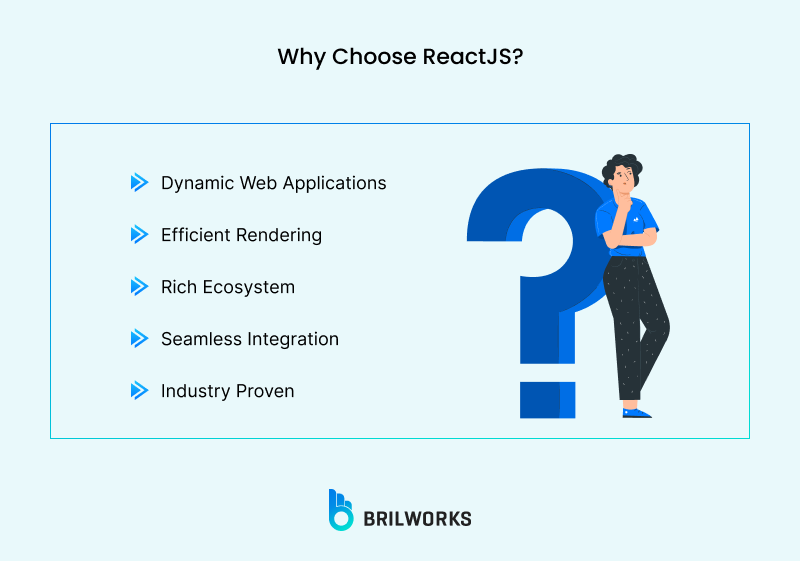
Dynamic Web Applications: React is specifically designed for building interactive user interfaces on the web. Its component-based architecture makes it easy to break down complex UIs into manageable, reusable parts.
Efficient Rendering: With its virtual DOM, React minimizes direct interactions with the actual DOM, ensuring fast and smooth updates that improve overall performance in data-driven applications.
Rich Ecosystem: Enjoy access to a vast ecosystem of libraries, tools, and community support. Whether you need state management with Redux or routing with React Router, the extensive ecosystem makes development more streamlined.
Seamless Integration: React works naturally with HTML and CSS, making it a perfect choice if you have a strong web development background. This integration facilitates the development of modern, responsive, and SEO-friendly web applications.
Industry Proven: Trusted by major companies like Netflix, Airbnb, and Instagram, React has a proven track record of scalability and reliability for building high-performance web interfaces.
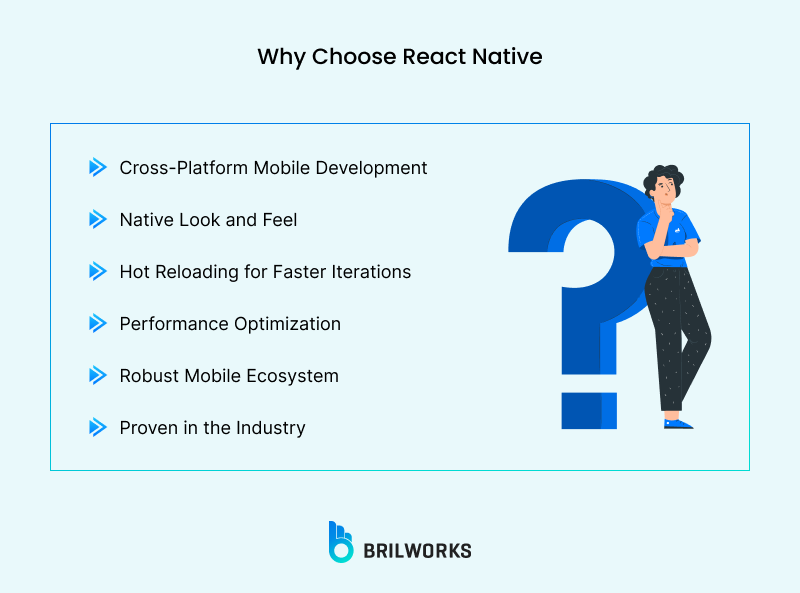
Cross-Platform Mobile Development: React Native allows you to write one codebase that runs on both iOS and Android, significantly reducing development time and maintenance costs while delivering native-like performance.
Native Look and Feel: By mapping components like <View> and <Text> to native UI elements, React Native ensures that your mobile app not only looks native but also provides a smooth, responsive user experience.
Hot Reloading for Faster Iterations: With hot reloading, you can see changes immediately without restarting the app, which speeds up development, debugging, and overall productivity.
Performance Optimization: React Native bridges JavaScript with native code via a dedicated bridge, ensuring high performance for animations, gestures, and other mobile-specific features, often outperforming traditional hybrid solutions.
Robust Mobile Ecosystem: There is a growing collection of third-party libraries and community-driven solutions designed specifically for mobile development. This ecosystem supports functionalities like advanced navigation, device integrations, and performance tuning.
Proven in the Industry: Major companies such as Facebook, Instagram, and Uber Eats use React Native to build their mobile apps. Its ability to deliver high-quality, cross-platform mobile experiences makes it a trusted choice in today’s mobile-first world.
While React and React Native are designed for different platforms (web and mobile), they can complement each other in a unified project strategy. Here’s how businesses and developers leverage both technologies together:
React (ReactJS) and React Native both use JavaScript/TypeScript, enabling teams to reuse non-UI code across web and mobile apps. For example:
API Calls: Both React and React Native can use the same API endpoints to fetch and send data, eliminating the need to write duplicate backend interaction code.
State Management: Libraries like Redux, Zustand, or MobX work seamlessly in both ecosystems, ensuring consistent data handling across platforms.
Utility Functions: Common utilities, such as data validation, date formatting, authentication logic, and calculations, can be reused without modifications.
Example:
A fintech app might use React for its web dashboard and React Native for its mobile app. The logic for calculating interest rates or fetching transaction history can be shared, reducing duplication and maintenance effort.
Meta’s React Native Web allows React Native components to run in web browsers. This means:
Code Reusability: A significant portion of the code written for React Native can be directly used in a web application.
Consistent UI/UX: By sharing styles and components, businesses can provide a uniform experience across devices.
Faster Development: Teams don’t need to rebuild interfaces for each platform, accelerating the development process.
Use Case:
Twitter (now X) uses React Native Web to render its mobile app components on the web, ensuring a cohesive experience.
For projects targeting both web and mobile, developers can structure shared components (buttons, forms, etc.) to work in both React and React Native.
Implementation tips:
Abstract Platform: Specific Code: Using .web.js and .native.js file extensions allows components to have platform-specific implementations when necessary.
Use Cross-Platform Libraries: Tools like React Primitives and Restyle help standardize styling and component behavior across web and mobile.
Some businesses don’t need identical apps on both web and mobile but rather companion applications that serve different user needs. In this case, React powers the web version, while React Native is used for a mobile-friendly experience.
Example Use Case:
An e-commerce business may have:
A React-powered website for product discovery, detailed browsing, and checkout.
A React Native mobile app optimized for quick purchases, push notifications, and personalized recommendations.
While React and React Native can be integrated, there are some challenges developers should be aware of:
UI Differences: Web applications rely on hover effects, larger screen layouts, and traditional navigation bars, while mobile apps prioritize touch interactions, gestures, and bottom navigation.
Performance Tradeoffs: While logic can be shared, animations and high-performance UI components often require platform-specific optimizations for smooth performance.
Learning Curve: Developers need familiarity with both React and React Native, along with platform-specific considerations (e.g., working with iOS/Android native modules).
Startups: If you're building an MVP, sharing code across web and mobile can speed up development and reduce costs.
Enterprise Applications: Large businesses maintaining both admin panels (React) and user-facing mobile apps (React Native) can benefit from shared logic and components.
Cross-Platform Teams: Development teams familiar with JavaScript can maximize productivity by leveraging their existing skills without diving into Swift or Kotlin.
When working with any technology, it’s important to be aware of common pitfalls and challenges that you might encounter. Both ReactJS and React Native have their unique challenges, but with the right strategies, you can avoid or mitigate these issues.
Mismanaging state or overusing it in large components can cause frequent and unnecessary re-renders, slowing down your application.
How to Avoid: Keep state as localized and minimal as possible. Use memoization techniques like React.memo (or shouldComponentUpdate in class components) to prevent redundant updates. Consider using state management libraries like Redux or MobX to organize your state more efficiently.
When components become too large or responsibilities are blurred, your code can turn messy, making debugging and future maintenance challenging.
How to Avoid: Design components following the single responsibility principle. Break down your UI into small, reusable components and adopt patterns such as container vs. presentational components. This organization improves readability and scalability.
Improper handling of asynchronous data, such as unoptimized API calls or redundant fetch operations, can lead to slow and unresponsive interfaces.
How to Avoid: Use hooks like useEffect properly for data fetching, and consider debouncing or caching responses to optimize network requests. Tools like React Query can help manage and synchronize server state effectively.
Relying solely on client-side rendering can hurt your SEO, as search engines may struggle to index dynamically generated content.
How to Avoid: Implement server-side rendering (SSR) using frameworks like Next.js, or leverage prerendering strategies to ensure that your content is visible and indexable by search engines.
Differences in behavior between iOS, Android, and other platforms can lead to a fragmented user experience if not managed correctly.
How to Avoid: Test your application on multiple devices and platforms. Utilize platform-specific code and styling via the Platform module to handle differences in UI behavior and performance.
React Native’s bridge, which facilitates communication between JavaScript and native code, can become a bottleneck, especially when handling heavy computations or frequent UI updates.
How to Avoid: Offload performance-critical operations to native modules when needed. Monitor performance using profiling tools and optimize rendering or animations to reduce bridge overhead.
Implementing complex navigation patterns in mobile apps can be challenging, particularly when integrating deep linking or managing state across multiple screens.
How to Avoid: Leverage mature navigation libraries like React Navigation. Keep your navigation structure as simple as possible, and refactor periodically to maintain clarity and responsiveness.
The React Native ecosystem, while growing, may include libraries that are not as mature or well-supported, which can lead to compatibility issues.
How to Avoid: Evaluate third-party libraries carefully before integrating them into your project. Prefer those with active communities and robust documentation, and stay updated with library changes to avoid integration issues.
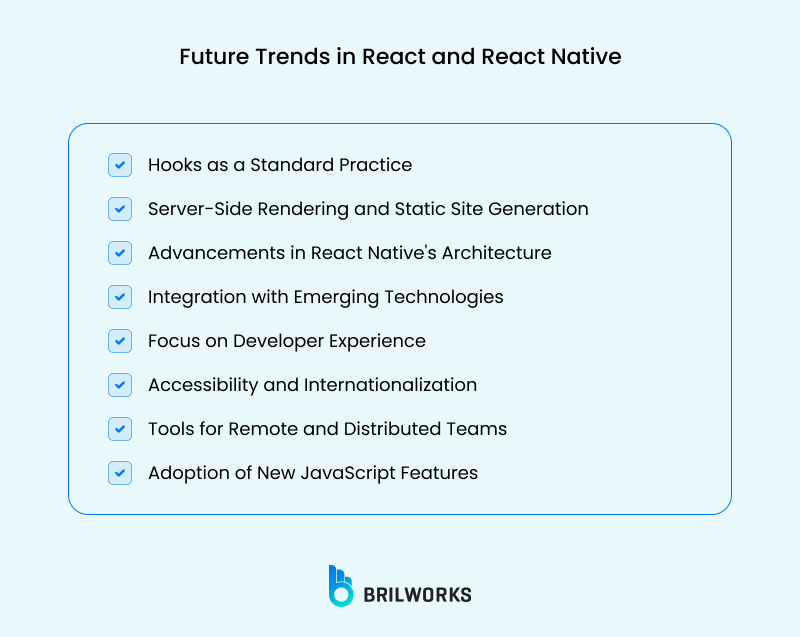
At last lets talk about the future. JavaScript has dominated web and mobile development for years, and its popularity is still growing. Unless a new programming language emerges and gains worldwide adoption, ReactJS and React Native will likely remain strong choices for developers.
That being said, history has shown that technology is unpredictable. We all saw what happened when Google released Flutter in 2017, two years after React Native emerged. While React Native was still in its prime, many expected it to stay on top. But Flutter quickly gained traction and, in some areas, even outperformed React Native.
That’s a discussion for another time. If you’re interested, check out our Flutter vs. React Native blog. For now, ReactJS and React Native continue to evolve, supported by Meta and a vast developer community. While new technologies will appear, React's flexibility and widespread use make it a reliable choice for the future.
Since their debut in React 16.8, hooks have transformed how developers build components. By enabling functional components to handle state and side effects, hooks simplify code and encourage reusable logic. Moving forward, expect hooks to solidify their role as a cornerstone of React development, with a growing library of custom hooks shared across projects to tackle common challenges.
Server-side rendering (SSR) and static site generation (SSG) are gaining momentum, thanks to frameworks like Next.js. These techniques boost performance, improve SEO, and deliver faster initial page loads—critical for today’s complex web apps. As developers prioritize efficiency, SSR and SSG will likely become standard practices in React projects.
React Native is undergoing a major overhaul with its new architecture, featuring the Fabric renderer and TurboModules. These updates promise better performance and tighter integration with native code, enabling developers to create more robust mobile apps. With competition from frameworks like Flutter, React Native’s focus on innovation will be key to maintaining its edge in cross-platform development.
React’s flexibility makes it a prime candidate for pairing with cutting-edge technologies. For example:
WebAssembly could unlock new possibilities for performance-heavy applications by running complex computations in the browser.
Machine learning integrations might enable smarter, more adaptive user interfaces that respond to user behavior in real time. As these technologies mature, React developers will have exciting tools to push application boundaries.
Enhancing developer experience remains a priority. Features like Concurrent Mode (still experimental) aim to make apps more responsive by prioritizing rendering tasks. Future tools may streamline workflows, improve debugging, and reduce complexity, ensuring React remains a joy to work with as projects scale.
With the web’s growing emphasis on inclusivity, accessibility and internationalization are becoming non-negotiable. React and React Native will likely see enhanced support for screen readers, keyboard navigation, and multi-language capabilities, helping developers build apps that reach diverse global audiences.
The rise of remote work has sparked demand for better collaboration tools. Expect React to integrate more seamlessly with version control systems, offer real-time coding features, and provide new ways to share reusable components—empowering distributed teams to work efficiently and maintain consistency.
As JavaScript evolves, React and React Native will adopt new language features to streamline development. Enhanced async programming, tighter TypeScript integration, and modern syntax will reduce reliance on external libraries and keep the frameworks aligned with the latest standards.
ReactJS and React Native are two sides of the same coin, both born from JavaScript’s versatility but designed for entirely different battlegrounds. ReactJS reigns supreme in crafting dynamic, high-performance web interfaces, while React Native empowers developers to build cross-platform mobile apps with near-native efficiency.
The differences boil down to this:
For the web: React (ReactJS) is your go-to library, leveraging the virtual DOM and component-driven architecture to create blazing-fast UIs.
For mobile: React Native bridges JavaScript with native code, delivering apps that feel at home on iOS and Android
But the real magic lies in their synergy. By combining React’s web prowess with React Native’s mobile capabilities, teams can reuse logic, streamline workflows, and deliver seamless experiences across platforms.
At the end of the day, technology is a means to an end. Whether you choose React, React Native, or another tool, focus on solving real problems for real users—the rest will follow.
Ready to build? Dive deeper into our React Native app development guide or contact our team to turn your vision into reality.
No, React (ReactJS) is a JavaScript library for building web applications, while React Native is a framework for creating mobile apps for iOS and Android.
Yes, developers can share business logic, state management, and APIs between React and React Native apps. Tools like React Native Web help bridge the gap.
React is often easier to start with since it focuses on web development. Once comfortable with React, transitioning to React Native for mobile apps becomes more manageable.
Yes, React apps depend on the browser's rendering engine, while React Native apps leverage native components, offering better performance for mobile applications.
If you're building a web app, go with React. If you need a mobile app with cross-platform compatibility, React Native is the better choice.
Get In Touch
Contact us for your software development requirements
Get In Touch
Contact us for your software development requirements